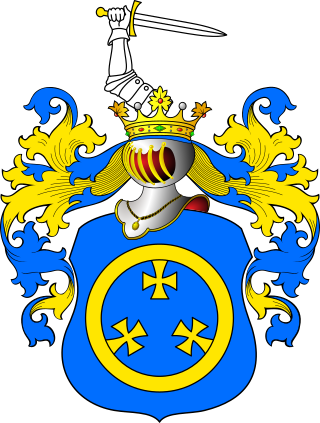See also
- Bydgoszcz Ignacy Jan Paderewski Airport (IATA: BZG, ICAO: EPBY), a Polish regional airport in the city of Bydgoszcz, Poland
Ignacy is a Polish given name. Notable people with the name include:

Radzyń Podlaskipronounced [ˈrad͡zɨɲpɔdˈlaskʲi] is a town in eastern Poland, about 60 km north of Lublin, with 15,808 inhabitants (2017). Situated in the Lublin Voivodeship since 1999, previously it was part of the Biała Podlaska Voivodeship (1975–1998). It is the capital of Radzyń Podlaski County, and historically belongs to the region of Lesser Poland. The town was founded in 1468, and its most important landmark is the rococo Potocki Palace.

Ignacy Wyssogota Zakrzewski (1745–1802) was a notable Polish nobleman, politician, art collector, Freemason, and the Mayor of Warsaw during the last years of the Polish–Lithuanian Commonwealth, in 1792 and 1794.
Władysław is a Polish given male name, cognate with Vladislav. The feminine form is Władysława, archaic forms are Włodzisław (male) and Włodzisława (female), and Wladislaw is a variation. These names may refer to:
Zygmunt, Zigmunt, Zigmund and spelling variations thereof are masculine given names and occasionally surnames. People so named include:
The ideas of the Age of Enlightenment in Poland were developed later than in Western Europe, as the Polish bourgeoisie was weaker, and szlachta (nobility) culture (Sarmatism) together with the Polish–Lithuanian Commonwealth political system were in deep crisis. The period of Polish Enlightenment began in the 1730s–40s, peaked in the reign of Poland's king, Stanisław August Poniatowski, went into decline with the Third Partition of Poland (1795) – a national tragedy inspiring a short period of sentimental writing – and ended in 1822, replaced by Romanticism.

Prince Antoni Stanisław Czetwertyński-Światopełk (1748–1794) was a nobleman (szlachcic) and politician in the Polish–Lithuanian Commonwealth.
Marcin Knackfus, also known in Lithuanian as Martynas Knakfusas, was an architect, professor, and military captain from the Polish–Lithuanian Commonwealth.

Rakowicki Cemetery is a historic necropolis and a cultural heritage monument located on 26 Rakowicka Street in the centre of Kraków, Poland. It lies within the Administrative District No. 1 Stare Miasto meaning "Old Town" – distinct from the Kraków Old Town situated further south. Founded at the beginning of the 19th century when the region was part of Austrian Galicia, the cemetery was expanded several times, and at present covers an area of about 42 hectares. Many notable Cracovians, among them the parents of Pope John Paul II, are buried here.

The Konarski Secondary School is a coeducational public secondary school in Rzeszów, Poland. Founded in 1658, it is one of the oldest secondary schools in Poland. Located in the old town in a historic building designed by Tylman van Gameren, it plays an important role in the cultural life of Rzeszów and Subcarpathia Province.
Konstanty may refer to:

Ledóchowski is the name of a Ruthenian, Polish and Austrian noble family of Ruthenian origin from Volhynia. Members of the family have over the centuries distinguished themselves through services to the Catholic Church, the Austrian Crown as well as the Polish Crown.
Franciszek is a masculine given name of Polish origin. It is a cognate of Francis, Francisco, François, and Franz. People with the name include:

Helena Maria Paderewska was a Polish social activist who helped found the Polish White Cross society during World War I, and also is known as the second wife and partial biographer of Polish patriot, prime minister and musician Ignacy Jan Paderewski.

Clan Ostoja (Moscics) is one of the largest and oldest knightly and heraldic families in Europe, belonging to the Polish nobility. The family is sealed with the Ostoja coat of arms.